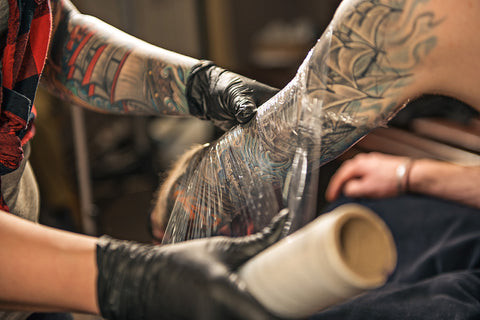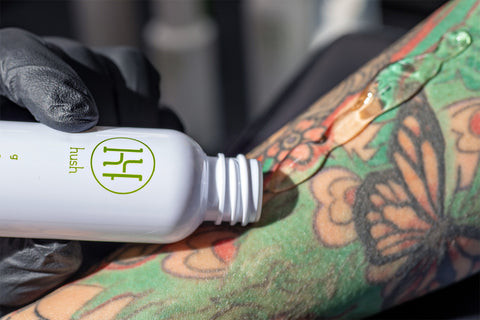Are you noticing a strange fluid bubble under your tattoo bandage and wondering “What Is An Ink Sack After Tattoo?” An ink sack is a normal part of the tattoo healing process, and tattooat.com is here to guide you through it. Understanding what it is, why it forms, and how to properly care for it will ensure your tattoo heals beautifully, preserving the vibrant tattoo colors and intricate tattoo designs you envisioned. Let’s dive into the world of tattoo aftercare and ink sacks, ensuring your body art remains a masterpiece with proper tattoo maintenance and skin protection.
1. Understanding the Tattoo Ink Sack Phenomenon
What Exactly Is a Tattoo Ink Sack?
A tattoo ink sack is a pocket of fluid that accumulates under the protective bandage (often Saniderm) applied to a new tattoo. This fluid is primarily composed of plasma, a component of blood, mixed with excess tattoo ink. According to research from Portland State University’s Art Department, in July 2023, plasma is released by the body to aid in wound healing, and it’s a natural response to the trauma the skin undergoes during tattooing. This is normal wound exudate as part of the healing process.
Why Does an Ink Sack Form?
The formation of an ink sack is a physiological response. When a tattoo is created, the skin is punctured thousands of times, leading to inflammation and the release of plasma. The bandage creates a sealed environment, trapping this fluid. This fluid contains elements that promote healing.
What Are the Key Components of the Fluid in an Ink Sack?
The fluid primarily consists of:
- Plasma: A yellowish fluid that carries blood cells and contains proteins, electrolytes, and antibodies essential for healing.
- Ink: Excess ink that the body naturally expels during the initial healing phase.
- Lymph: A fluid that helps remove waste and toxins from the body.
2. Distinguishing Normal Ink Sacks from Potential Problems
How Can You Tell if an Ink Sack Is Normal?
A normal ink sack is typically clear or slightly tinted with the color of the tattoo ink. The skin around the tattoo should not be excessively red, swollen, or painful.
When Should You Be Concerned About an Ink Sack?
Be concerned if you observe the following:
- Excessive Redness or Swelling: This could indicate an infection.
- Foul Odor: This is a sign of potential bacterial contamination.
- Greenish or Yellowish Pus: This is a clear indicator of infection.
- Fever or Chills: These are systemic symptoms that warrant immediate medical attention.
- Excessive Bleeding: While some pinkish tint is normal, bright red blood in large quantities is not.
What Steps Should You Take if You Suspect an Infection?
If you suspect an infection, take these steps:
- Contact Your Tattoo Artist: Seek their professional opinion and guidance.
- Consult a Doctor: Obtain medical advice and potential treatment.
- Follow Aftercare Instructions: Strictly adhere to cleaning and care protocols.
3. The Role of Protective Sheets Like Saniderm
What Is Saniderm and How Does It Work?
Saniderm is a breathable, waterproof bandage that is often applied to new tattoos. It protects the tattoo from external contaminants, keeps the area moist to promote healing, and reduces the risk of scabbing.
What Are the Benefits of Using Saniderm?
- Protection: Acts as a barrier against bacteria and dirt.
- Moisture Retention: Keeps the tattoo hydrated, which is crucial for healing.
- Reduced Scabbing: Minimizes the formation of thick scabs, which can pull out ink.
- Convenience: Allows you to shower and go about your daily activities without worrying about direct contact with the tattoo.
How Long Should You Keep Saniderm On?
Most tattoo artists recommend keeping the initial Saniderm bandage on for 24-72 hours. Subsequent bandages can be applied for several days, as advised by your artist.
4. Managing Ink Sacks: Dos and Don’ts
Should You Pop an Ink Sack?
Absolutely not. Popping an ink sack introduces bacteria into the wound, increasing the risk of infection. It can also damage the tattoo and lead to scarring.
How Should You Handle a Leaking Ink Sack?
If the ink sack leaks, remove the bandage carefully. Gently wash the tattoo with mild, fragrance-free soap and water. Pat it dry with a clean paper towel, and if instructed by your artist, apply a new bandage.
What Are the Best Practices for Removing a Bandage with an Ink Sack?
- Wash Your Hands: Ensure your hands are clean to prevent infection.
- Loosen the Edges: Gently peel back the edges of the bandage.
- Peel Slowly: Pull the bandage down in the direction of hair growth.
- Wash the Tattoo: Clean the area with mild soap and water.
- Pat Dry: Use a clean paper towel to dry the tattoo thoroughly.
- Apply Aftercare: Apply a thin layer of recommended aftercare ointment.
5. Preventing Excessive Ink Sack Formation
Can You Prevent Ink Sacks Altogether?
You cannot completely prevent ink sacks, as they are a natural part of the healing process. However, you can minimize their formation by following proper aftercare instructions.
What Factors Contribute to Excessive Ink Sack Formation?
- Over-Moisturizing: Applying too much ointment can trap moisture.
- Tight Bandages: Bandages that are too tight can restrict fluid drainage.
- Individual Healing Response: Some people naturally produce more plasma.
What Aftercare Practices Can Help Minimize Ink Sacks?
- Apply Ointment Sparingly: Use a thin layer of aftercare ointment.
- Change Bandages Regularly: Follow your artist’s instructions for bandage changes.
- Keep the Area Clean: Gently wash the tattoo twice a day with mild soap and water.
- Avoid Irritants: Steer clear of harsh soaps, perfumes, and tight clothing.
6. Identifying and Addressing Tattoo Bubbling
What Is Tattoo Bubbling and How Does It Differ from an Ink Sack?
Tattoo bubbling refers to the formation of small blisters or bubbles directly on the tattooed skin, rather than under a bandage. This is different from an ink sack, which is a collection of fluid under the protective sheet. Tattoo bubbling is a sign of excessive moisture trapped in the outer layer of skin.
What Causes Tattoo Bubbling?
- Excessive Moisture: Over-application of aftercare products.
- Poor Air Circulation: Not allowing the tattoo to air out.
- Prolonged Exposure to Water: Soaking the tattoo for too long.
How Should You Treat Tattoo Bubbling?
- Gently Pat Dry: Use a clean paper towel to absorb excess moisture.
- Air Dry: Allow the tattoo to air out for short periods.
- Reduce Ointment Use: Apply a thinner layer of aftercare ointment.
- Avoid Soaking: Limit exposure to water during showers or baths.
7. Long-Term Tattoo Aftercare and Maintenance
What Are the Key Steps in Long-Term Tattoo Aftercare?
- Moisturize Regularly: Keep the tattoo hydrated with a fragrance-free lotion.
- Protect from the Sun: Apply sunscreen to prevent fading.
- Avoid Harsh Chemicals: Steer clear of strong soaps and detergents.
- Stay Hydrated: Drinking plenty of water keeps your skin healthy.
How Does Sun Exposure Affect Tattoos?
Sun exposure can cause the tattoo ink to fade and the skin to become damaged. Always apply a high-SPF sunscreen to protect your tattoo.
What Products Are Safe for Long-Term Tattoo Maintenance?
- Fragrance-Free Lotions: Keep the skin moisturized without irritation.
- Sunscreen: Protects against UV damage and fading.
- Mild Soaps: Gentle cleansers that won’t strip the skin of its natural oils.
 Fresh Tattoo with Saniderm Bandage
Fresh Tattoo with Saniderm Bandage
8. Understanding the Healing Process Timeline
What Is the Typical Timeline for Tattoo Healing?
- Week 1: Initial inflammation and fluid discharge.
- Week 2: Scabbing and itching.
- Week 3: Scabs begin to fall off.
- Week 4-6: Skin regeneration and color settling.
What Factors Can Affect the Healing Time?
- Size and Location of the Tattoo: Larger tattoos and those in areas with more movement may take longer to heal.
- Individual Health: A healthy immune system promotes faster healing.
- Aftercare Compliance: Following aftercare instructions diligently.
When Should You Consult a Tattoo Artist or Doctor About Healing Concerns?
Consult a professional if you experience:
- Signs of Infection: Redness, swelling, pus.
- Excessive Pain: Unusually severe discomfort.
- Prolonged Healing: No improvement after several weeks.
9. Common Misconceptions About Tattoo Aftercare
Myth: Tattoos Need to “Breathe” to Heal
While airflow is important, tattoos need moisture to heal properly. Protective bandages like Saniderm allow the skin to breathe while maintaining a moist environment.
Myth: Scabbing Is Always Bad
Some scabbing is normal, but thick scabs can pull out ink. Proper aftercare minimizes scabbing.
Myth: You Should Pick at Scabs
Picking at scabs can lead to scarring and ink loss. Let scabs fall off naturally.
10. Choosing the Right Tattoo Aftercare Products
What Ingredients Should You Look for in Aftercare Products?
- Moisturizers: Shea butter, cocoa butter, vitamin E.
- Antimicrobials: Tea tree oil, calendula.
- Soothing Agents: Aloe vera, chamomile.
What Ingredients Should You Avoid in Aftercare Products?
- Alcohol: Dries out the skin.
- Fragrances: Can cause irritation.
- Harsh Chemicals: Can damage the tattoo.
What Are Some Recommended Tattoo Aftercare Brands?
- HUSH Anesthetic: Known for its healing sprays and balms.
- Aquaphor: A classic ointment for protecting and moisturizing.
- Sanibalm: Specifically designed for tattoo aftercare.
 HUSH Anesthetic Tattoo Aftercare Products
HUSH Anesthetic Tattoo Aftercare Products
11. The Importance of Choosing a Reputable Tattoo Artist
How Does the Artist’s Technique Affect Healing?
A skilled artist will use proper techniques to minimize trauma to the skin, promoting faster and more effective healing.
What Questions Should You Ask a Tattoo Artist Before Getting Inked?
- What Aftercare Products Do You Recommend?
- What Is Your Preferred Method of Bandaging?
- How Long Have You Been Tattooing?
- Can I See Your Portfolio?
How Can You Ensure the Tattoo Studio Is Clean and Safe?
- Check for Sterilization Equipment: Autoclaves are essential for sterilizing equipment.
- Observe Hygiene Practices: Artists should wear gloves and use disposable needles.
- Read Reviews: See what other clients say about their experiences.
12. Addressing Specific Concerns and Scenarios
What If Your Tattoo Is Itchy?
Itching is a normal part of the healing process. Avoid scratching the tattoo, as this can damage the skin and lead to infection. Apply a soothing lotion or balm to relieve itching.
What If Your Tattoo Is Peeling?
Peeling is also normal. Do not pick at the peeling skin. Allow it to come off naturally.
What If Your Tattoo Is Raised?
A slightly raised tattoo is common, especially in areas with thicker skin. If the raised area is excessively bumpy or itchy, consult your artist or a doctor.
13. The Psychological Aspect of Tattoo Healing
How Can the Healing Process Impact Your Mental Well-Being?
The healing process can be stressful, especially if you are worried about infection or improper healing.
What Strategies Can Help You Stay Positive During Healing?
- Educate Yourself: Understanding the healing process can alleviate anxiety.
- Follow Aftercare Instructions: Taking proactive steps can give you a sense of control.
- Stay Connected: Share your experiences with other tattoo enthusiasts.
- Focus on the End Result: Visualize your beautifully healed tattoo.
How Can You Manage Anxiety About Potential Complications?
- Trust Your Artist: Rely on their expertise and guidance.
- Seek Professional Advice: Consult a doctor if you have concerns.
- Practice Mindfulness: Focus on the present moment and avoid dwelling on potential problems.
14. Advanced Tattoo Aftercare Techniques
What Is Wet Healing?
Wet healing involves keeping the tattoo covered with a moisture-retentive bandage like Saniderm. This promotes faster healing and reduces scabbing.
What Is Dry Healing?
Dry healing involves leaving the tattoo uncovered and applying a thin layer of ointment. This method requires more frequent cleaning and moisturizing.
What Are the Pros and Cons of Each Method?
| Method | Pros | Cons |
|---|---|---|
| Wet Healing | Faster healing, reduced scabbing, less maintenance. | Risk of trapped moisture, potential for allergic reaction to bandage. |
| Dry Healing | Allows the skin to breathe, less risk of moisture buildup. | Slower healing, more scabbing, requires more frequent care. |
15. Exploring Cultural Perspectives on Tattoo Healing
How Do Different Cultures Approach Tattoo Aftercare?
Different cultures have unique traditions and beliefs about tattoo aftercare. Some cultures use natural remedies like coconut oil or herbal balms. Others emphasize spiritual cleansing and protection.
What Role Does Tradition Play in Tattoo Healing Practices?
Tradition often plays a significant role in shaping aftercare practices. For example, some indigenous cultures have rituals and ceremonies to promote healing and protect the tattoo.
How Can You Incorporate Traditional Wisdom into Modern Aftercare?
You can incorporate traditional wisdom by using natural and gentle products, respecting the healing process, and honoring the cultural significance of tattoos.
16. Staying Informed About New Developments in Tattoo Aftercare
What Are Some Recent Innovations in Tattoo Aftercare Products?
Recent innovations include CBD-infused balms, probiotic lotions, and advanced bandage technologies.
How Can You Stay Up-To-Date on the Latest Aftercare Research?
- Follow Tattoo Industry Blogs: Stay informed about new products and techniques.
- Attend Tattoo Conventions: Learn from artists and experts.
- Consult with Your Tattoo Artist: Seek their advice and recommendations.
What Are Some Reliable Sources for Tattoo Aftercare Information?
- Tattooat.com: A comprehensive resource for tattoo enthusiasts.
- Inked Magazine: A leading publication in the tattoo industry.
- Professional Tattoo Artists: Experienced artists are valuable sources of information.
17. Legal and Ethical Considerations in Tattoo Aftercare
What Are the Legal Requirements for Tattoo Aftercare Information?
Tattoo artists are legally required to provide clients with detailed aftercare instructions.
What Are the Ethical Responsibilities of Tattoo Artists Regarding Aftercare?
Artists have an ethical responsibility to ensure their clients understand how to care for their tattoos and to provide ongoing support and guidance.
How Can You Ensure You Are Receiving Accurate and Safe Aftercare Advice?
- Verify Credentials: Ensure your artist is licensed and certified.
- Seek Second Opinions: Consult with multiple artists if you have concerns.
- Research Products: Choose aftercare products from reputable brands.
18. The Future of Tattoo Aftercare
What Trends Are Shaping the Future of Tattoo Aftercare?
Trends include personalized aftercare plans, eco-friendly products, and advanced healing technologies.
How Will Technology Impact Tattoo Aftercare Practices?
Technology may lead to innovations like smart bandages that monitor healing progress and telemedicine consultations for aftercare support.
What Role Will Sustainability Play in Future Aftercare Products?
Sustainability will become increasingly important as consumers seek eco-friendly and ethically sourced aftercare products.
19. FAQ: Addressing Common Questions About Tattoo Ink Sacks
1. Is an ink sack always a sign of infection?
No, an ink sack is usually a normal part of the healing process and not necessarily a sign of infection. However, you should monitor for other signs of infection like excessive redness, swelling, or pus.
2. Can I shower with an ink sack?
Yes, if you have a waterproof bandage like Saniderm, you can shower. Just be sure to follow your artist’s instructions and avoid prolonged exposure to water.
3. How long does it take for an ink sack to go away?
The ink sack usually forms within the first 24-48 hours and will either leak out on its own or be removed when you take off the initial bandage, typically after 24-72 hours.
4. What happens if I accidentally pop the ink sack?
If you accidentally pop the ink sack, gently clean the area with mild soap and water. Pat it dry and apply a thin layer of aftercare ointment. Monitor for signs of infection.
5. Can an ink sack affect the color of my tattoo?
The ink in the sack is excess ink that the body is expelling. It should not affect the final color of your tattoo if you follow proper aftercare instructions.
6. What should I do if my tattoo is still leaking after a few days?
It’s normal for your tattoo to weep some fluid for the first two or three days. If it’s still leaking excessively after the third day, contact your tattoo artist for advice.
7. Is it normal for the area around the ink sack to be red?
Some redness is normal, but excessive redness, swelling, or pain could indicate an infection.
8. Can I exercise with an ink sack?
It’s best to avoid strenuous exercise while your tattoo is healing. Sweat and friction can irritate the tattoo and increase the risk of infection.
9. What kind of soap should I use to clean my tattoo after removing the ink sack bandage?
Use a mild, fragrance-free, and antibacterial soap to gently clean the tattoo. Avoid harsh chemicals or exfoliating scrubs.
10. How often should I moisturize my tattoo after the ink sack phase?
Moisturize your tattoo 2-3 times a day, or as needed, with a fragrance-free lotion to keep the skin hydrated and prevent dryness.
20. Conclusion: Embracing the Tattoo Journey
Understanding “what is an ink sack after tattoo” is a key part of ensuring your body art heals beautifully and remains vibrant for years to come. By following these guidelines and staying informed, you can navigate the healing process with confidence and enjoy your stunning new tattoo. At tattooat.com, we are dedicated to providing you with the knowledge and resources you need to make your tattoo journey a success.
Ready to explore a world of stunning tattoo designs, discover talented artists, and gain invaluable aftercare knowledge? Visit tattooat.com today and embark on your ultimate tattoo adventure! Whether you’re seeking inspiration for your next tattoo, searching for a skilled artist in the USA, or simply looking to expand your knowledge of tattoo culture, we have everything you need. Explore our extensive collection of tattoo designs, connect with top-rated artists in Portland and beyond, and dive into our informative articles on tattoo aftercare, styles, and history. Your perfect tattoo experience awaits!
Address: 1825 SW Broadway, Portland, OR 97201, United States.
Phone: +1 (503) 725-3000.
Website: tattooat.com.

